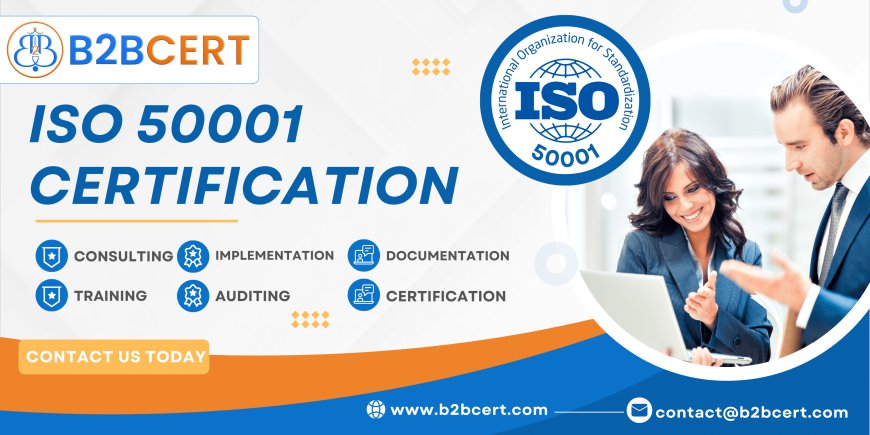ISO 50001 Certification in Australia: Driving Energy Management Excellence
ISO 50001 certification in Australia empowers organizations to take control of their energy use, reduce costs, and meet sustainability goals. By adopting this globally recognized standard, Australian businesses not only enhance their operational efficiency but also contribute to national and international efforts to create a more sustainable future
ISO 50001 certification is an internationally recognized standard for energy management systems (EnMS). It provides organizations with a structured framework to improve energy performance, enhance energy efficiency, and reduce energy costs. ISO 50001 Certification in Australia is increasingly adopted across various industries to align with sustainability goals, regulatory requirements, and global best practices for energy management.
Overview of ISO 50001 Certification
ISO 50001, developed by the International Organization for Standardization, focuses on establishing, implementing, maintaining, and improving an energy management system. It is designed to help organizations systematically monitor energy use, identify inefficiencies, and implement changes to optimize energy performance. The certification ensures compliance with a comprehensive energy management process that includes energy planning, policy creation, operational controls, and performance evaluation.
The certification applies to organizations of all sizes and sectors, making it particularly versatile for Australia’s diverse economy. From large manufacturing firms and energy-intensive industries to smaller enterprises and public institutions, ISO 50001 supports any entity aiming to manage energy use more effectively.
Key Features and Benefits of ISO 50001
-
Enhanced Energy Efficiency
ISO 50001 Services in Australia enables organizations to identify energy-saving opportunities, such as optimizing energy-intensive processes, upgrading equipment, and adopting renewable energy solutions. Improved efficiency leads to reduced operational costs and a lower environmental footprint. -
Regulatory Compliance
Australia has implemented stringent energy and climate policies, including mandatory energy efficiency standards and reporting frameworks like the National Greenhouse and Energy Reporting (NGER) Scheme. ISO 50001 aligns with these requirements, helping organizations stay compliant with local and international regulations. -
Sustainability and Carbon Reduction
Adopting ISO 50001 demonstrates a commitment to sustainability. By improving energy performance, organizations contribute to national and global efforts to reduce greenhouse gas emissions and combat climate change. -
Improved Competitiveness
Certification showcases a company’s dedication to operational excellence and environmental responsibility. This can improve reputation, foster trust with stakeholders, and create competitive advantages in markets that value sustainability. -
Integration with Other Standards
ISO 50001 seamlessly integrates with other management systems like ISO 9001 (Quality Management) and ISO 14001 (Environmental Management), enabling organizations to develop a unified approach to efficiency and performance.
ISO 50001 Certification Process in Australia
-
Gap Analysis
Organizations typically begin by conducting a gap analysis to assess current energy management practices against the requirements of ISO 50001. This step identifies areas for improvement and helps in planning the certification process. -
Developing the EnMS
The next step involves creating or refining an energy management system based on ISO 50001 standards. This includes: -
Establishing an energy policy.
-
Setting measurable energy objectives and targets.
-
Allocating resources and responsibilities for energy management.
-
Implementation
Organizations implement the EnMS, focusing on operational controls, energy monitoring, training, and employee engagement. Data collection and analysis play a critical role during this stage. -
Internal Audit and Review
Conducting an internal audit ensures the system’s readiness for certification. Management reviews and corrective actions address any identified non-conformities. -
Certification Audit
A third-party certification body assesses the organization’s EnMS for compliance with ISO 50001 Audit in Australia. Successful completion of the audit results in certification. -
Continual Improvement
ISO 50001 emphasizes ongoing improvement through periodic reviews, updates, and audits to maintain certification and adapt to changing energy demands.
Adoption of ISO 50001 in Australia
Australia’s emphasis on energy efficiency and renewable energy has made ISO 50001 increasingly relevant. Sectors such as manufacturing, mining, construction, and healthcare are notable adopters due to their energy-intensive operations. Government initiatives and financial incentives, such as the Emissions Reduction Fund (ERF) and Clean Energy Finance Corporation (CEFC) funding, further encourage businesses to invest in energy management systems.
Additionally, certification is a strategic tool for organizations aiming to align with Australia’s carbon-neutral goals and achieve significant cost savings in a competitive business environment. With rising energy prices and growing public awareness about sustainability, ISO 50001 offers a practical pathway for businesses to future-proof their operations.
Conclusion
ISO 50001 Consultants in Australia empowers organizations to take control of their energy use, reduce costs, and meet sustainability goals. By adopting this globally recognized standard, Australian businesses not only enhance their operational efficiency but also contribute to national and international efforts to create a more sustainable future. As the country continues to transition toward cleaner energy, ISO 50001 remains a vital tool for driving progress in energy management and climate responsibility.

